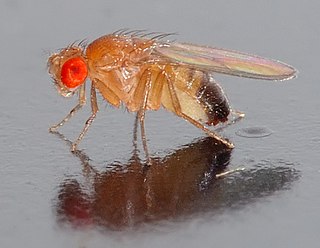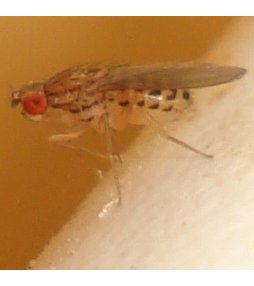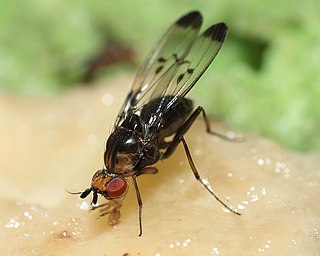
The Drosophilinae are the largest subfamily in the Drosophilidae. The other subfamily is the Steganinae.

The paraphyletic subgenus Sophophora of the genus Drosophila was first described by Alfred Sturtevant in 1939. It contains the best-known drosophilid species, Drosophila melanogaster. Sophophora translates as carrier (phora) of wisdom (sophos). The subgenus is paraphyletic because the genus Lordiphosa and the species Hirtodrosophila duncani are also placed within this subgenus.
The subgenus Siphlodora belongs to genus Drosophila and consists of two species that share a sigmoid-shaped posterior crossvein. Phylogenetically, the subgenus is positioned within the virilis-repleta radiation.

The subgenus Dorsilopha belongs to genus Drosophila and consists of four species. The phylogenetic position of this group has been unclear for a long time, but recent studies have shown that the subgenus is positioned ancestral to the subgenus Drosophila.
The subgenus Dudaica belongs to genus Drosophila and consists of two species, Drosophila malayana and Drosophila senilis Duda, 1926.
The Holarctic Drosophila populi species group belongs to the subgenus Sophophora and contains two species, Drosophila ingrica and Drosophila populi. D. ingrica is found in the Palearctic, while D. populi is found in the Nearctic. Both species are found in the northernmost subarctic forest zone, and are strongly associated with cottonwood trees.

The genus Zaprionus belongs to the family fruit fly Drosophilidae and is positioned within the paraphyletic genus Drosophila. All species are easily recognized by the white longitudinal stripes across the head and thorax. The genus is subdivided in two subgenera, based on the presence of an even or odd number of white stripes. The species of the genus can be found in Africa and Southern Asia. One species, Zaprionus indianus, has invaded the New World.

Drosophila appendiculata is a large yellowish fruitfly found in Southern Chile and neighboring Argentina. The species is placed in its own unique subgenus, Chusqueophila, based on the presence of three partial cross-veins in the wing.
Drosophila tripunctata is a species of vinegar fly in the Immigrans-tripunctata radiation of the subgenus Drosophila.

Drosophila immigrans is a species of vinegar fly in the family Drosophilidae. Drosophila immigrans is a member of the Immigrans-tripunctata radiation of the subgenus Drosophila. It is related to the Drosophila quinaria and Drosophila testacea species groups, and the fellow Immigrans species group member Drosophila albomicans. Drosophila immigrans has been used in evolutionary studies to understand how viruses evolve with their hosts.

Lordiphosa is a genus of fly in the family Drosophilidae.

The Drosophila immigrans species group is a polyphyletic and speciose lineage of Drosophila flies, including over 100 species. Immigrans species belong to the Immigrans-tripunctata radiation of the subgenus Drosophila. Well-described species include Drosophila immigrans, and the sister species Drosophila albomicans and Drosophila nasuta. The genome of D. albomicans was sequenced in 2012 in an effort to characterize novel sex chromosome development in D. albomicans. Immigrans group species are related to mushroom-breeding Drosophila of the Quinaria and Testacea species groups.

The Hawaiian Drosophilidae are a lineage of flies within the genus Drosophila. This monophyletic clade includes all of the endemic Hawaiian Drosophila and all members of the genus Scaptomyza, which contains both Hawaiian and non-Hawaiian species. The Hawaiian Drosophilidae are descended from a common ancestor estimated to have lived 25 million years ago. Species of Hawaiian Drosophilidae flies have been studied as models of speciation and behavioral evolution. Along with other members of the native Hawaiian ecosystem, the conservations status of many species of Hawaiian Drosophilidae is threatened by habitat loss and introduced predators, among other factors.
Drosophila acanthomera is a species of fruit fly in the genus Drosophila.
Drosophila albipalpis is a species of fly in the subgenus Dudaica.
Drosophila gracilipalpis is a species of fly in the subgenus Dudaica.
Drosophila puberula is a species of fly in the subgenus Dudaica.
Drosophila malayana is a species of fly in the subgenus Dudaica.
Drosophila senilis is a species of fly; it is the type species of the subgenus Dudaica.
The Drosophila virilis species group is a species group of fruit flies in the subgenus Drosophila.







